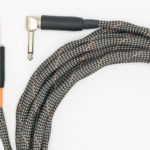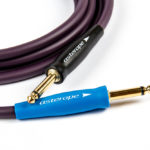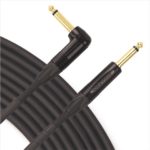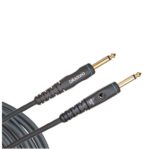Can Guitar Cables Really Change Your Tone? (Hear For Yourself and Decide)
Mark Marshall’s new course, Producing and Recording Electric Guitar is out now.
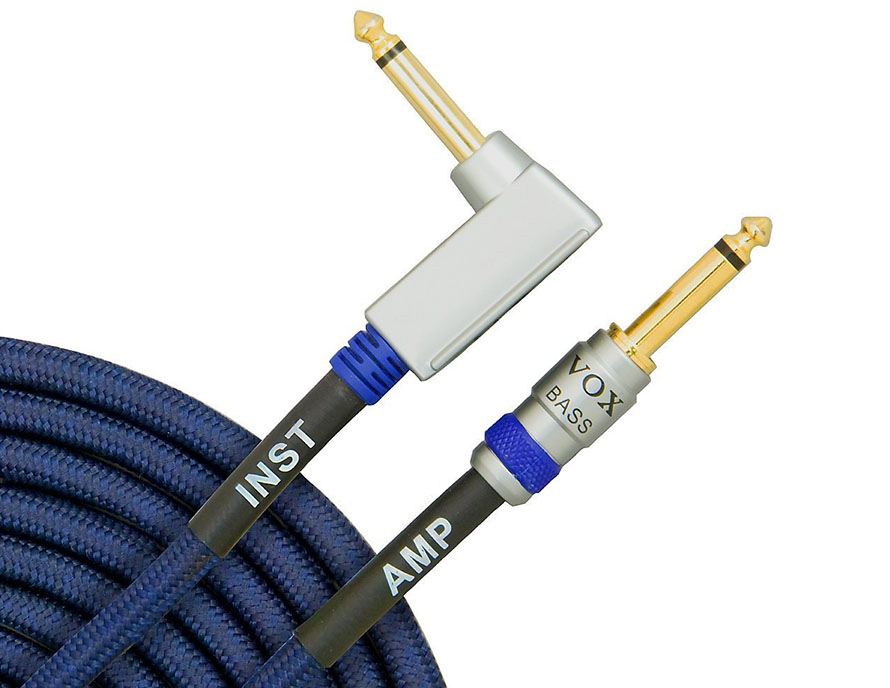
Is it all just hype, or does your choice in cable really make a difference? Read on and listen below to find out for yourself.
For a long time, there has been a debate amongst guitarists about the differences a guitar cable can make in your tone. Some say there is no audible variation at all, and that any claim of such is mere hype.
Scientifically, the idea that cables could make a difference it isn’t hype at all. The longer a cable is, the more capacitance gets added, and more noise is introduced. When there’s enough of it, this is what causes treble loss or what we guitarists call “tone suck”.
As a simple way of thinking about it, let’s consider that pickups have to push an electrical signal through a cable. However, they don’t have an unlimited amount of push. The longer the cable is, the more push it takes. As the push required increases, we lose high end in our tone.
Guitar pickups put out a high impedance, or “High Z” signal. High Z signals are not great for long cable runs, which is why balanced Low-Z cables and buffers were created. (A buffer turns your High-Z signal into a Low Z signal, which is much more equipped for long distance travel.)
But because we have two cables that are the same length doesn’t mean they will be the same capacitance.
Higher end cables do tend to be made with better materials. Vovox cables, for instance, are made with a solid core of pure copper. They’re also made with low capacitance and a separate conductor for ground. Even the materials to which they wrap the cord are designed to reduce interference and microphonics.
Step into the Guitar Laboratory
I decided to do an experiment to not only test if guitarists can hear a change, but just what changes they hear in their tone. The purpose of this exercise isn’t to prove an expensive cable will sound “better” then a cheap one. If we put reliability aside, tone is a very personal thing.
To help settle the issue, and give you a chance to hear and decide for yourself how significant these differences are, I conducted a pair of tests and created some audio files. You’ll be able to listen to them for yourself below, or you can download the full resolution files directly by clicking here.
The Live Tests
The first batch of examples are physically played. It’s not a loop. For at least one set of sample, I thought it was important to capture the relationship between the pickup and the amp.
There was nothing between the guitar an amp: Guitar, 10ft cable, amp. Capacitance is extremely important with this setup. It is in a situation like this you can expect hear the most variation in your tone.
Of course, there’s a problem with this type of test. There is always the question of how much subtle variations in playing might influence tone.
I’m a pretty consistent player. I’ve been schooled by many a producer over the years. I could do a punch-in on a session and match the tone and velocity exactly. However, even with my experience, there may be a slight difference. Through my extensive testing of the cables, I have found that what you will hear is representative of the tone of each cable, even with subtle performance variations.
But it gets more complicated: Since it’s hard to easily make this this test double-blind, could my own expectations of each cable subconsciously influence my playing to help produce the changes I expect to hear—even if I am very careful to play consistently, with the same exact technique and intensity each time.
I doubt it, and these small natural variations probably aren’t playing that big of a role in the examples. But to help offset this possible critique, I’ve included a second test as well.
The Looped Tests
For those of you that need even more proof, the second batch of examples rely on loops, either through a looping pedal, or played back through a DAW and re-amped. Here, we can be sure to hear an absolutely consistent performance, and we’re taking the live interaction of the cable and guitar pickups out of the equation.
Remember when I was talking about capacitance and impedance? Once issue here is that using a looper pedal will introduce a buffer into our single chain. This means it will convert our signal from a High Z signal to a Low Z signal. So, we gain one thing and lose another.
To me, the purest example detecting variation in guitar tone can be hear when plugging straight to amp. However, it’s good to hear how a cable can influence tone later in the chain, or after the introduction of a buffer. If you use true bypass pedals, your signal will not be buffered when in bypass mode. Thus, re-introducing the influence of the cable on your tone.
Test 1: Live Performance
The first three sets of examples were all were recorded with the same signal chain: An AEA A840 Ribbon Mic and an API 312 mic pre into a UAD Apollo interface. The amps were close-mic’d to pick up as much detail as possible. Each of these sets of examples uses a different guitar and amp combination.
For each guitar and amp combo, I used one of 4 different cables: a Vovox, Asterope, Livewire and Planet Waves cable:
To help you listen to this test blind, I won’t tell you which is which, and will just label them A,B, C, and D. Each example puts these cables in a different random order so you can pick your favorite each time, and an answer key will be at the end of the article.
As you listen to each example, write down if you hear a change between A, B, C, or D. If so, which ones sound best to you?
I did some preliminary testing with some gifted musicians and artists. One thing was for sure: MOST heard a difference.
Which cable was their favorite was a personal thing, as was the relevance of the magnitude of the differences between cables. This is expected. Tastes and sensitivity vary. But, I think we can say that most players and audio professionals DO sense a difference.
Before we get started, remember to fire up your best pair of speakers or headphones. It doesn’t really make any sense to try and discern these differences on a laptop or phone speaker. If you do that and I find out, I’m going to have to call your mom and tell her you’re a terrible person. And that you hate kittens.
Now, the moment you’ve been waiting for!
ex1: 1964 Guild Starfire III with Humbuckers into a Vox AC15TBX
ex2: Stratocaster into a Headstrong Lil King Reverb (Blackface Princeton Reverb-style)
ex3: Gibson Les Paul with Florence Humbuckers into a Henry Amps Bad Hombre
Reverse Cable
Some higher end cables have a recommended direction, which should exhibit the least capacitance and the highest preservation of tone. For this next test, I wondered, “What would it sound like if I ran each cable in the opposite direction it was intended?”
For this example, I used a Danelectro DC10 with single coils into a Vox AC15TBX. Recorded with an AEA A840 and API 312. Let’s listen.
The differences were quite subtle in these. I don’t think it’s the end of the world if you plug them in backwards. To my ears, it sounded a little less bright when run in the wrong direction. I did still prefer it in its intended direction. We’re splitting hairs at this point, though.
Test 3: Getting Loopy
The first set of examples focus on the difference a cable makes when plugged in directly from the guitar to amp. For the second set of examples, I’ll use a looper to play back the same performance.
For these tests, I used a Pigtronix Infinity Looper. The signal will be buffered, and I used only one guitar amp combination: Strat into a Headstrong Lil King Reverb.
Now that we’ve listened to all of these examples, how do you feel about the changes in the sound? Are the differences significant in each example? Do you have a favorite across the board?
Personally, I don’t hear much of a difference at all on the looper examples. Some people might jump to claim this is because the playing is identical in each version. However, I believe there is something bigger at play here: The buffer is basically balancing out the difference in the cables. The interaction between guitar and amp isn’t as directly.
From this example, it seems if you play with a buffer, it diminishes the variations in cable choice. This is good for those that like buffers and have them in their rigs.
I’m not a big fan of most buffers. I do like the Analog Man buffer and a Klon buffer, but some cheaper buffers don’t sound pleasing to me. Even though using a buffer can even out cable variances, the buffer may not be flattering. It could be a case of bringing all the cables down to the same lower level of sound quality.
Test 4
Fortunately, there’s one more test we can do, and it has some serious real world applications as well. To help get us a bit closer to the best of both worlds, we can record a guitar directly into a DAW and then “reamp” it..
For those who have bever used one, a reamp box is designed to take a DI guitar part you recorded and turn it back into a High Z signal so you can run it through an amplifier afterwards at your leisure. This way, your guitar amp receives a signal similar to what a guitar pickup would put out. Think of it as being a bit like a DI box in reverse.
With the looping examples, there was a buffer involved which changed our guitar signal to Low Z and changed out results. But using a reamp box will allow us to get a lot closer to repeating an exact performance through different cables.
For these examples, I recorded the performance direct into my UAD Apollo using a Gibson ES335 with Florence Humbuckers. I then reamped it through a Vox AC15TBX using a Radial JCR Reamp Box.
One thing to note about reamping: I like to make sure I have the same guitar lying around that I’m reamping. Different guitars have different output. To help ensure we’re going to send an authentic signal to the amp, we need to plug in and compare the reamped signal with the signal that comes straight out of the guitar.
To do this, I would plug my 335 direct into the AC15 and listen to the volume. Then, plug in the reamp and compare. It took several comparisons and adjustments to the signal coming out of the reamp bix to get it just right.
Let’s listen to the 4 examples again this way:
Did you hear a difference? Unlike the looper examples, I think the differences are clear.
As a side note: I found the tone straight from guitar to amp was superior to the reamped tone, even after trying to match them as best as possible. There was a little bit of presence that got lost when reamping, to my ear.
I wouldn’t say it’s a deal breaker, and if you don’t have any other option but to revamp later, go for it. You could still end up getting preferable results that way, depending on the situation. But if you have the ability to, I still recommend sitting in the live room with a short cable to the amp. But I’m a total tone snob (in case you have noticed).
How Far Can You Go?
By now, I think it should be clear that different cables can make for a slightly different tone. But length of cable plays a part in tone as well. The longer the cable the more load. This tends to make your tone duller.
The influential blues fusion guitarist, Clarance Gatemouth Brown, used to play a telecaster into a Fender Quad Reverb on 10, with the treble all the way up and bass all the way down! Can you imagine how bright the resulting sound would be without his mammoth 100ft cable mellowing out the tone?
Short, low capacitance cables don’t sound better to everyone, however. Some prefer that vintage high capacitance or long cable sound. For those that do prefer the sound of shorter cables, some companies, like Vovox, have found a way to lengthen cables without having tone loss.
I generally try to stick to 10ft cables when I can, especially in the studio. Sometimes in live situations, I have to use a 20ft lead to my amp. It’s a compromise I make for the circumstances.
I’ve been in some studios that use a lot of long cables. Some engineers will have the guitarist sit in the control room. They end up using at least 30ft of cable to get to the amp, or will use a DI and a reamper to make an even longer run, introducing a buffer into the mix.
In general, I don’t feel like this brings out the most natural qualities of the amp. Unless, like I mentioned, you like the sound of a bit of signal loss.
I understand why some producers and engineers like to do this. It simplifies communication. You don’t have to hit the talk back button every time you have a comment. You could potentially improve real-time tone-sculpting decisions or inform a performance by letting the player hear their tone in context, through the speakers, as part of the full mix. However, you do lose some sonic integrity.
I still prefer to be in the room with the amp. There is a relationship the guitar and amp have together. It’s most notable with feedback. But before feedback even happens, the guitar and amp are talking to each other and resonating together.
I’ll use 10ft cables and sit fairly close to the amp. About the same distance I would for a gig. Remember that the amp too is an instrument. I’m playing it as much as I am playing the guitar.
A guitar amp, for many great players, is not just a PA for your guitar. It’s an extremely interactive component in the character of your tone. This is also why people like me tend to be concerned with things like guitar cables.
The takeaway? Try using short cable leads to your amp. Doing this with any brand cable will improve your tone.
Consistency
These days, I’ve been able to achieve consistent tones, no matter which stage or studio I go to. There was a time when this wasn’t so regular. I would be surprised by variables that I hadn’t accounted for.
I was unaware of the differences in each cable I owned. I didn’t have a character profile for each one. It was more of a random selection when it came to packing up. Now I know what each cable sounds like. So when I pick an amp to play, I know how things will pair.
Yes, that means I have to go into super geek mode and make notes for each amp, guitar, and cable I own. As I noticed in these examples, some cables sounded better with certain rigs. I’ll want to make note of this.
With an understanding of how these elements combine, I can pretty much walk into any room and have my sound. It has really sped up my setup time. And getting to know your cables as intimately as your amps can speed up yours too.
If this sounds tedious to you, know that aside from getting lucky, people get great sounds by knowing their gear. Understanding and acting on these finer details can help you bring your tone to life.
Pedalboard Warning
A lot of guitarists use a pedalboard with their amps. I would like to mention that the cables you use between pedals are extremely important. Don’t just put your focus on the leads to your board and to your amp.
I’ve seen and heard a lot of tone get lost in patch cables. You’ll notice that higher end brands like Vovox and Asterope both make patch cables. This is good to know if you like the sonic identity of either of these cables In these tests.
Avoid the cheap multi-color cables with molded ends you see in stores. Not only do they break easily, they sound like … (you fill in that blank.)
I have had great success with the following options:
Disaster Area Designs make my favorite solderless cables. They sound great and are the only ones that have actually worked for me. They weren’t that hard to put together and they are reliable. So many other brands like George L’s (which sound great) have failed on me on numerous occasions.
Fulltone patch cables also sound good to me, and don’t weigh down my guitar tone. The con is that the jacks are quite large. This presents problems when trying to squeeze pedals together. There are a lot of times I just can’t use them on a pedalboard, even though I like the sound.
EBS makes flat patch cables. They are small, and because the design of the cable is flat, it allows you to squeeze pedals really close. They also sound way better then I expected for such an inexpensive cable!
Pocket Full Of Cash
I realize money is a difficult subject for many. I would say that if you can, try not to be put off by expensive cables. I’ve seen many a guitarist buy a drawer full of pedals, only to cheap out on cabling.
As you’ve heard in these examples, cables can, do and will change your tone. Think about everything you put between your guitar and amp. Find cables you like, and don’t be put off if you have to spend some money. Buy one less pedal. A couple of good cables will make all the rest of your pedals sound better, and can have a greater impact in your overall presentation of sound.
The Results
Test 1
ex1A: Vovox
ex1b: Asterope
ex1c Planet Waves
ex1d Live wire
ex2a Planet Waves
ex2b Vovox
ex2c Livewire
ex2d Asterope
ex3a Asterope
ex3b Livewire
ex3c Vovox
ex3d Planet Waves
Test 3(2)
ex5(4)a Asterope Cable Forward
ex5(4)b Asterope Cable Backwards
ex5(4)c Vovox Cable Froward
ex5(4)d Vovox Cable Backwards
Test 2 (3)
ex4(5)a Vovox
ex4(5)b Asterope
ex4(5)c Livewire
ex4(5)d Planet Waves
Test 4
ex6a Vovox
ex6b Asterope
ex6c Livewire
ex6d Planet Waves
My Personal Results
Personally, I keep going back to the Vovox and Asterope. They tended to be my favorites over all. Not because they’re more expensive. But, because I like what they bring to the tone party.
I typically didn’t like the Planet Waves cable. I’m betting even though it was a 10ft cable, it was higher capacitance then the others. As I mentioned, this results in high end loss which I don’t like. What about you?
The point isn’t so much what my favorites are. It’s to find what cables are your favorite. Let us know what you think in the comments below.
Mark Marshall is a producer, songwriter, session musician and instructor based in NYC. His new course, Producing and Recording Electric Guitar is out now.
Please note: When you buy products through links on this page, we may earn an affiliate commission.







